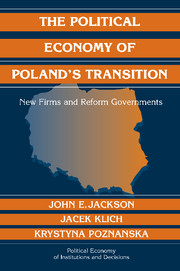Book contents
- Frontmatter
- Contents
- List of Tables
- List of Figures
- Acknowledgments
- List of Abbreviations
- 1 Why Poland?
- 2 The Dynamics of the Polish Political Economy, 1990–1997
- 3 Creative Destruction and Economic Transition
- 4 The Social and Distributional Costs of Transition
- 5 Individual Attitudes and Voting
- 6 De Novo Job Creation and Election Returns
- 7 Liberal Economic Interests and Seat Allocations
- 8 The Political Economy after 1997
- 9 The Political Economy of Transition: Why Poland?
- Appendix A Assessing Measures of New and Small Firms in Poland
- References
- Index
- Titles in the series
4 - The Social and Distributional Costs of Transition
Published online by Cambridge University Press: 07 August 2009
- Frontmatter
- Contents
- List of Tables
- List of Figures
- Acknowledgments
- List of Abbreviations
- 1 Why Poland?
- 2 The Dynamics of the Polish Political Economy, 1990–1997
- 3 Creative Destruction and Economic Transition
- 4 The Social and Distributional Costs of Transition
- 5 Individual Attitudes and Voting
- 6 De Novo Job Creation and Election Returns
- 7 Liberal Economic Interests and Seat Allocations
- 8 The Political Economy after 1997
- 9 The Political Economy of Transition: Why Poland?
- Appendix A Assessing Measures of New and Small Firms in Poland
- References
- Index
- Titles in the series
Summary
The Polish transition, though successful in the aggregate, did not happen without considerable pain, and the success was not uniformly distributed throughout the country and among all segments of society. Table 2.2 shows that the unemployment rate escalated dramatically during the early reform years, reaching 17 percent in 1993, and even by 1997 was still close to double digits. Real wages, though they increased after 1993, did not return to prereform levels. These data indicate that, even though GDP exceeded prereform levels and grew at impressive rates, there were still reasons to be concerned about the quality of economic life, even several years after the reforms began. These aggregate conditions led some to question the pace, direction, and even the philosophy behind the reforms.
The previous chapter made it clear that some regions adapted more quickly and successfully to the transition. People in these areas were better equipped to start and grow new enterprises. Regions that entered the transition with good communications infrastructure, with higher levels of education, with a larger number of small private firms, and that created and expanded local development agencies and banks fared much better than other areas. The impact of the transition was also very unevenly distributed among individual Poles. One's age, work history, attitudes, and education were highly correlated with the ease or difficulty of the transition. Experiencing these benefits and costs naturally affected how one evaluated the reforms and how one began to affiliate politically.
- Type
- Chapter
- Information
- The Political Economy of Poland's TransitionNew Firms and Reform Governments, pp. 98 - 121Publisher: Cambridge University PressPrint publication year: 2005



